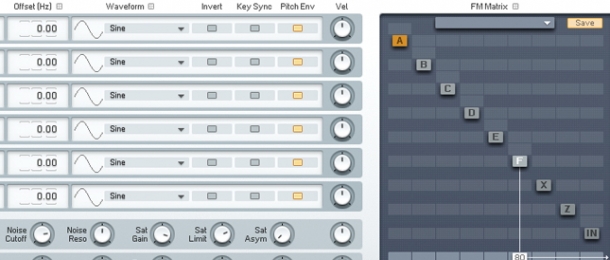
In the previous article, we looked at how FM synthesis works and also took a quick look at FM8's sections. However, the real power of FM8 lies in using its FM Matrix for modulation. The FM Matrix is found under the 'Expert' tab in FM8's interface.
It's here that we can configure our FM routing: which of the six oscillators (referred to as 'operators' in FM8) is modulating which, and which ones we want to hear in the output.
An essential characteristic of FM8 is that the operators (oscillators) can be both modulators and carriers at the same time, meaning that we can create complex networks of modulation and feedback.
Modulating Operators
By default, operator F is our main carrier. In new patches, we can hear it when we play the keyboard as it is already routed to the output bus. This bus is found along the bottom of the square, in the second to last row. (The last row itself is where we pan the carriers in the stereo output). To modulate operator F, we mix the output of, say, operator E by clicking and dragging on the slot below E and on the same row as F. We can now hear the sidebands- the timbre sounds brighter and fuller.
To hear the frequency contouring effect of modulating at low frequencies, change the 'Ratio' control in operator E's row of controls to 0.0010. If you play a concert A (440Hz, the one above middle C), you will hear the pitch vibrato slowly above and below 440Hz. The pitch is actually changing at a rate of 4.4Hz, as the modulator's frequency is 1/100th of the carrier's frequency. Using the 'Offset' control to add or subtract a few Hz in your patches can make your sounds less static, by introducing slight phasing and pitch instability.
Feedback
Let's experiment with some feedback. If you set operator E's frequency ratio back to 1.0000, and now route operator F to operator E, the number of sidebands will increase exponentially as each of our original sidebands now has sidebands of its own. This explosion in the number of harmonics to the sound means that FM8 can get pretty close to white noise, without the noise generator (operator X) patched in! A small amount of feedback can be a good way to warm up a sound by adding some harmonics at integer multiples of the sound's fundamental frequency.
Using FM8 for Basic Additive Synthesis
FM isn't the only type of synthesis that FM8 can do: it can also be used as a basic additive synthesiser, like an organ. Each of the six oscillators (or 'operators' in FM8's lingo, labelled A - F) can be independently pitched, and routed straight to the output. Whilst FM synthesis has us routing the operators into each other (modulation), routing individual operators directly to the output means that their signals are simply added together.
To do this, go to the FM Matrix, under the 'Expert' tab. In an initialised (empty) patch, operator F should already by connected to the output bus: the second row from the bottom. The number in this particular slot denotes operator F's volume, from 0 - 100. Now, click and drag upwards in the slot immediately to the left, and then right-click on operator E in the matrix. You will be able to hear operator E, too, at the volume you set in it's slot on the output bus.
Using the frequency ratio controls, we can change the pitches of the operators to those of naturally (or unnaturally) occurring harmonics. So for example, leave operator F at the fundamental (ratio 1.0000), change operator E to ratio 2.0000, operator D ratio 3.0000 and so on. Route operators D - A to the output, if you haven't done so already. Now, half the output mix of each operator as compared to the one below it in pitch, so: F 100, E 50, D 25, etc.
The output now sounds like a low pass filtered saw wave. Using frequency ratios 1, 3, 5, 7, 9, 11 gives us a filtered-sounding square wave, which will have a clarinet-like timbre. Using the output bus mixes, you can change the timbre balances of the sounds much like how the drawbars on an organ affect its sound.
See our FM8: MIDI Setup tutorial for some eye-opening tips on how to spice up the MIDI in your life!
Check out our FM8 presets range as well to kick-start your FM Matrix experiments.













